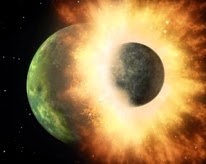| Online: | |
| Visits: | |
| Stories: |

| Story Views | |
| Now: | |
| Last Hour: | |
| Last 24 Hours: | |
| Total: | |
Moon Formed When Earth Struck By Another Planet 4.5 BillionYears Ago, Giant Impact Theory Confirmed By German Scientists
Scientists from the Universities of Göttingen, Cologne, and Münster in Germany have resolved an isotopic difference between the Earth and the Moon. The slight variation in oxygen isotopes confirms the “Giant impact“ hypothesis of Moon formation, according to which the Moon formed from the debris of a giant collision between the Earth and another proto-Planet about 4.5 billion years ago. The results were published in the journal Science.
Only a few laboratories worldwide are able to measure the rare 17O isotope at all. “For the last three years, staff and students in Göttingen have persistently worked on improving the analytical procedure,” says Prof. Dr. Andreas Pack, head of the Stable Isotope Laboratory at Göttingen University’s Geoscience Centre. “The results of this study show that this effort has paid off.” Some of the data were measured by student Bjarne Friedrichs for his Bachelor’s thesis.
Original publication: Daniel Herwartz, Andreas Pack, Bjarne Friedrichs, Addi Bischoff. Identification of the giant impactor Theia in lunar rocks. Science 2014. Doi: 10.1126/science.1251117.
Contacts and sources:
Dr. Daniel Herwartz
University of Cologne – Environmental Isotope Geochemistry
Source: http://www.ineffableisland.com/2014/06/moon-formed-when-earth-struck-by.html




